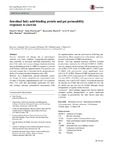Intestinal fatty acid-binding protein and gut permeability responses to exercise
| dc.contributor.author | March, DS | |
| dc.contributor.author | Marchbank, Tania | |
| dc.contributor.author | Playford, Raymond | |
| dc.contributor.author | Jones, AW | |
| dc.contributor.author | Thatcher, R | |
| dc.contributor.author | Davison, Glen | |
| dc.date.accessioned | 2017-12-05T10:01:07Z | |
| dc.date.available | 2017-12-05T10:01:07Z | |
| dc.date.issued | 2017-05 | |
| dc.identifier.issn | 1439-6319 | |
| dc.identifier.issn | 1439-6327 | |
| dc.identifier.uri | http://hdl.handle.net/10026.1/10364 | |
| dc.description.abstract |
PURPOSE: Intestinal cell damage due to physiological stressors (e.g. heat, oxidative, hypoperfusion/ischaemic) may contribute to increased intestinal permeability. The aim of this study was to assess changes in plasma intestinal fatty acid-binding protein (I-FABP) in response to exercise (with bovine colostrum supplementation, Col, positive control) and compare this to intestinal barrier integrity/permeability (5 h urinary lactulose/rhamnose ratio, L/R). METHODS: In a double-blind, placebo-controlled, crossover design, 18 males completed two experimental arms (14 days of 20 g/day supplementation with Col or placebo, Plac). For each arm participants performed two baseline (resting) intestinal permeability assessments (L/R) pre-supplementation and one post-exercise following supplementation. Blood samples were collected pre- and post-exercise to determine I-FABP concentration. RESULTS: Two-way repeated measures ANOVA revealed an arm × time interaction for L/R and I-FABP (P < 0.001). Post hoc analyses showed urinary L/R increased post-exercise in Plac (273% of pre, P < 0.001) and Col (148% of pre, P < 0.001) with post-exercise values significantly lower with Col (P < 0.001). Plasma I-FABP increased post-exercise in Plac (191% of pre-exercise, P = 0.002) but not in the Col arm (107%, P = 0.862) with post-exercise values significantly lower with Col (P = 0.013). Correlations between the increase in I-FABP and L/R were evident for visit one (P = 0.044) but not visit two (P = 0.200) although overall plots/patterns do appear similar for each. CONCLUSION: These findings suggest that exercise-induced intestinal cellular damage/injury is partly implicated in changes in permeability but other factors must also contribute. | |
| dc.format.extent | 931-941 | |
| dc.format.medium | Print-Electronic | |
| dc.language | en | |
| dc.language.iso | eng | |
| dc.publisher | Springer Science and Business Media LLC | |
| dc.subject | Strenuous exercise | |
| dc.subject | Intestinal permeability | |
| dc.subject | Core temperature | |
| dc.subject | Bovine colostrum | |
| dc.subject | Cell damage | |
| dc.subject | Cellular injury | |
| dc.subject | Urinary L/R | |
| dc.title | Intestinal fatty acid-binding protein and gut permeability responses to exercise | |
| dc.type | journal-article | |
| dc.type | Journal Article | |
| dc.type | Randomized Controlled Trial | |
| plymouth.author-url | https://www.webofscience.com/api/gateway?GWVersion=2&SrcApp=PARTNER_APP&SrcAuth=LinksAMR&KeyUT=WOS:000399218500009&DestLinkType=FullRecord&DestApp=ALL_WOS&UsrCustomerID=11bb513d99f797142bcfeffcc58ea008 | |
| plymouth.issue | 5 | |
| plymouth.volume | 117 | |
| plymouth.publication-status | Published | |
| plymouth.journal | European Journal of Applied Physiology | |
| dc.identifier.doi | 10.1007/s00421-017-3582-4 | |
| plymouth.organisational-group | /Plymouth | |
| plymouth.organisational-group | /Plymouth/Faculty of Health | |
| dc.publisher.place | Germany | |
| dcterms.dateAccepted | 2017-02-26 | |
| dc.identifier.eissn | 1439-6327 | |
| dc.rights.embargoperiod | Not known | |
| rioxxterms.versionofrecord | 10.1007/s00421-017-3582-4 | |
| rioxxterms.licenseref.uri | http://www.rioxx.net/licenses/all-rights-reserved | |
| rioxxterms.licenseref.startdate | 2017-05 | |
| rioxxterms.type | Journal Article/Review |


